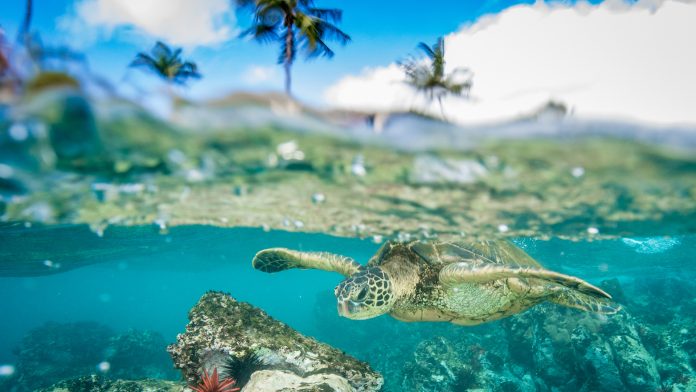An international research team, including Lancaster University, has revealed a list of 15 issues and the potential impact they could have on marine and coastal biodiversity.
The horizon scanning technique
The research team developed a horizon scanning technique to identify issues that are not currently receiving widespread attention but are likely to become important over the next decade. They intend to raise awareness and encourage investment into the full assessment of these issues now, and potentially drive policy change, to mitigate the issues before they have a major impact on biodiversity.
Researchers considered a wide array of issues, including the impacts of wildfires on coastal ecosystems, the impacts of new biodegradable materials on the marine environment, and an ‘empty’ zone at the equator as species move away from this warming region of the ocean.
“Marine and coastal ecosystems face a wide range of emerging issues that are poorly recognised or understood, each having the potential to impact biodiversity,” explained Dr James Herbert-Read, joint first author from the University of Cambridge’s Department of Zoology.
“By highlighting future issues, we are pointing to where changes must be made today – both in monitoring and policy – to protect our marine and coastal environments.”
The horizon scan involved 30 experts in marine and coastal systems from 11 countries in the global north and south, from a variety of backgrounds including scientists and policy-makers.
This study was recently published in the journal Nature Ecology and Evolution, and funded by Oceankind.
The rising demand for lithium for EV batteries may put environments at risk
Many of the issues discovered are linked to the exploitation of ocean resources. For example, deep sea ‘brine pools’ are unique marine environments home to a diversity of life, and house high concentrations of salts containing lithium. The research team has emphasised the potential risk associated with the rising demand for lithium for electric vehicle batteries, and the impact it could have on these environments. Scientists have called for rules to be implemented, to ensure biodiversity is assessed before deep sea brine pools are exploited.
Overfishing is considered an immediate problem, and so the horizon scan took this into consideration to look beyond this and contemplate what might happen next. The authors believe there may soon be a move to fishing in the deeper waters of the mesopelagic zone (a depth of 200m to 1,000m), where fish are not fit for human consumption, however, can be sold as food to fish farms.
“There are areas where we believe immediate changes could prevent huge problems arising over the next decade, such as overfishing in the ocean’s mesopelagic zone,” observed Dr Ann Thornton, joint first author from the University of Cambridge’s Department of Zoology.
“Curbing this would not only stop overexploitation of these fish stocks but reduce the disruption of carbon cycling in the ocean – because these species are an ocean pump that removes carbon from our atmosphere.”
The potential impact of biodegradable materials on marine biodiversity
Additionally, the report highlights the potential impact of new biodegradable materials on the ocean. Some of these materials are more toxic to marine species than traditional plastics.
“Governments are making a push for the use of biodegradable materials – but we do not know what impacts these materials may have on ocean life,” said Herbert-Read.
Scientists warn that the nutritional content of fish is declining as a consequence of climate change. Essential fatty acids are usually produced by cold-water fish species, so as climate change raises ocean temperatures, the production of these nutritious molecules is reduced. Thus, such changes may have impacts on both marine life and human health.
“The variety of ecosystems that are highlighted, from coral reefs to deep-sea brine pools, hammers home the broad reach of human impacts on our oceans. Mitigation of some issues, like lithium extraction, are open to direct intervention while others, such as wildfire impacts, will be dependent on global efforts to limit climate change,” noted Dr Sally Keith, co-author of the report, and Senior Lecturer in Marine Biology at the Lancaster Environment Centre.
New technologies may have a positive impact on marine biodiversity
Researchers noted that not all of the predicted impacts are negative. Authors believe the development of new technologies, such as soft robotics and better underwater tracking systems, will enable scientists to learn more about marine species and their distribution. This, in turn, will guide the development of more effective marine protected areas. However, they also warn that the impacts of these technologies on biodiversity must be assessed before they are deployed at scale.
“Our early identification of these issues, and their potential impacts on marine and coastal biodiversity, will support scientists, conservationists, resource managers, policy-makers and the wider community in addressing the challenges facing marine ecosystems,” concluded Herbert-Read.
Currently, there are a variety of well-known issues facing ocean biodiversity, including climate change, ocean acidification and pollution. However, this study focused on lesser-known emerging issues that could soon have significant impacts on marine and coastal ecosystems.
This horizon scanning process has previously been utilised by researchers from the ‘Department of Zoology’ to identify issues that have later come to prominence, for example, a scan in 2009 gave an early warning that microplastics could become a major problem in marine environments.
The United Nations has designated 2021 to 2030 as the ‘UN Decade of Ocean Science for Sustainable Development.’ In addition, the fifteenth Conference of the Parties (COP) to the United Nations Convention on Biological Diversity will conclude negotiations on a global biodiversity framework in late 2022. The aim is to slow and reverse the loss of biodiversity and establish goals for positive outcomes by 2050.









